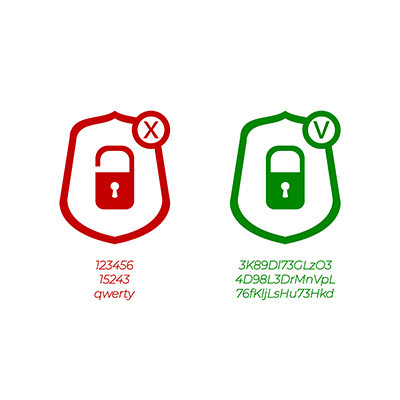GTIN Managed IT Blog
Cybersecurity is important. Scroll through a few pages of our blog and you’ll see article after article talking about threats and ways to make yourself and your business less vulnerable to cyberthreats. As an IT professional, however, I’d be so much happier if the state of the world didn’t require such a massive effort just to protect oneself and we could just talk about cool stuff you can do with modern technology all the time!
But alas, strong cybersecurity is crucial to virtually any organization, and it’s becoming even more important by the month.
For small businesses, having a fast, reliable Internet connection is needed to run all the digital tools that your staff has come to depend on. If you don’t have the bandwidth in place, you can deal with bottlenecks that can ruin communications, stall productivity, and cause operational issues of all types. Today, we’ll take a look at how to determine the amount of bandwidth you need to support your business’ computing infrastructure.
If your business uses Google Apps, then there is a good chance that you have some sort of integration set up with other services. If you grant permissions to other applications or programs to access and use Google Drive, you should know that you have some power over these permissions, and it’s incredibly important that you understand what permissions you are granting.
The telephone, as a technology, has been around for quite a while, more or less serving businesses for that entire time. Of course, we’ve seen quite a few advancements in telephony over the years, which has helped it to remain a cornerstone of modern business communications to this day in the form of Voice over Internet Protocol, or VoIP.
When you suffer a data breach, you might wonder how you can possibly come back from such an event, especially if it leads to a network compromise. Can your business rebound effectively, and if so, what do you need to do to make sure that it doesn’t happen again? It all starts with understanding how much data you need to function, as well as how much downtime you can afford to suffer from.
The metaverse is a buzzword that many companies have been throwing around in recent years, but what is it, exactly? You might want to sit down for this one, as it is going to get a little complicated and, perhaps, even a bit confusing. We’ll do our best to unpack what the metaverse is, why there is such an emphasis on it these days, and what you might expect to see from a metaverse in the future.
Depending on the size and complexity of your organization, managing technology can easily become a full-time job. If you are only calling a technician when you are dealing with a computer issue, then you might be sitting on a ticking time bomb. Whether you have internal staff responsible for managing your IT, or you rely on a third-party, you’ll want to make sure the following tasks are getting done.
When times get tough, businesses are pretty quick to start cutting costs wherever they can…and frequently, the business’ IT is the first thing to hit the chopping block.
While we contend that IT is the last thing you want to cut back on when times are tough, you may not have a choice. Therefore, we wanted to take a few moments to explore how you can resist some of these cuts—and if not, what you need to prioritize.
Simple passwords are just not an effective security practice, so if you’re still using credentials like Password, 123456, Guest, or Qwerty, listen up. You need better password hygiene practices before you suffer from a data breach. Here are some ways you can make a better password to protect your business from threats.
Small businesses have a lot to worry about in terms of technology, but one of the things that often gets overlooked is network security. Some small businesses feel that they are too small to be considered a viable target for hackers, but they are wrong; all businesses have data valuable for hackers in some form.
Setting up a router used to be a much more complex process than it is today. Thankfully, innovations in the technology have made it simpler and easier for consumers and businesses alike to do, to the point where some Internet service providers just let users do it themselves with guided instructions. Let’s go over how you can get the most out of your wireless router.
Anyone who wants to prioritize their privacy should be aware of the role the cache plays in such a thing. Your Google web browser—even on your smartphone—will store information about what you search so it can personalize your ads and recommendations, but if you would rather not have it do this all the time, you can clear your Android device’s Google search cache and set it up to auto-delete after a set amount of time has passed.
Technology is complex, and it’s definitely not everyone’s cup of tea. This is more the case for business technology than consumer technology. Even those who consider themselves tech-savvy might be lost when it comes to managing business-grade technology solutions. How can you make sure that your business technology is receiving the service it needs to stay operational long-term?
Most organizations are trying to figure out how to secure their IT against the constant flood of threats out there. Unfortunately, the biggest threat out there isn’t something that you can actively protect against. Can you guess what it is?
Unfortunately, it’s your employees, and their potentially lax password practices—and while you can’t really protect yourself against insecure passwords, you can minimize the likelihood that they’ll be used.
Remote work has seen unprecedented adoption in the past few years. While we’re all for the benefits that this trend brings, it is critical that any business that embraces remote or hybrid work does so securely.
Let’s discuss a few measures that your business can and should implement to achieve this security.
Software makes business run: that is an undeniable statement. From the operations software that allows your business to manage and pay its people to the CRM that provides a pathway to communicate efficiently with customers, to all of the applications that it takes to conduct business in earnest, software plays a crucial role in your business’ success.
The landscape of telephony for small businesses has changed dramatically. It’s likely that you don’t rely on your phone nearly as much as you rely on other technologies, like your Internet, communications solutions, and email. Still, an antiquated phone system can hold you back, so let’s explore the other viable option for your business: Voice over IP.




















